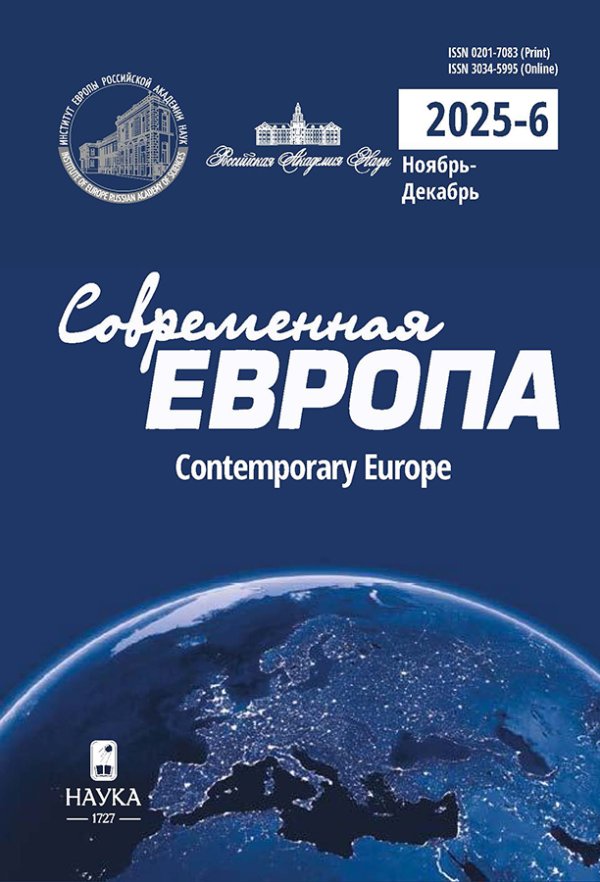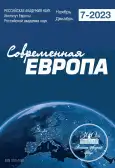Italian military presence in the Adriatic-Ionian macroregion
- Authors: Eremin D.P.1
-
Affiliations:
- Institute of Europe Russian Academy of Sciences
- Issue: No 7 (121) (2023)
- Pages: 215-224
- Section: Articles
- URL: https://journals.rcsi.science/0201-7083/article/view/255887
- DOI: https://doi.org/10.31857/S0201708323070173
- EDN: https://elibrary.ru/RVYRNI
- ID: 255887
Cite item
Full Text
Abstract
Keywords
About the authors
Denis Pavlovich Eremin
Institute of Europe Russian Academy of Sciences
Email: eremindp1994@gmail.com
Moscow, Russia
References
- Алексеенкова Е.С. (2019a) Италия и Франция: конфликт по вопросу будущего ЕC. Научно-аналитический вестник ИЕ РАН. № 1. С. 36-42.
- Алексеенкова Е.С. (2019b) Италия - ЕС: отказ от политики "суверенной изоляции"? Научно-аналитический вестник ИЕ РАН. № 5. С. 10-16.
- Зонова Т.В. (2016) История внешней политики Италии. Международные отношения, Москва. 352 с.
- Маслова Е.А. (2016) Европеизм и атлантизм во внешней политике Италии. Международные процессы. Т. 14. № 4. С.106-115.
- Маслова Е.А., Шебалина Е.О. (2022) США как фактор итальянской политики. Современная Европа. № 1. С. 35-48.
- Маслова Е.А., Шебалина Е.О. (2023) "Средиземноморская карта" в европейской политике Италии. Научно-аналитический вестник ИЕ РАН. № 2. С. 25-33.
- Перевалова А.А. (2018) Итальянская Республика в асимметричных конфликтах XXI в.: военные операции в Афганистане, Ираке и Ливане. Известия Уральского федерального университета (УрФУ). Серия 3: Общественные науки. Т. 13. №. 1(173). С. 88-102.
- Салаконе А. (2014) СССР и "нео-атлантическая" Италия в 1960-е гг. Итальянская республика в меняющемся мире. Под ред. А.А. Языковой. Институт Европы РАН, Москва. С. 110-122.
- Хобсбаум Э. (2004) Эпоха крайностей: короткий двадцатый век (1914-1991). Независимая газета, Москва. 632 с.
- Colombo S., Palm А. (2019) Italy in the Mediterranean: Priorities and Perspectives of a EU Middle Power. Foundation for Euroepan Progressive Studies, Brussels, Belgium. 35 р.
- Ignazi P., Giacomello G., Coticchia F. (2012) Italian Military Operations Abroad. Palgrave Macmillan, Basingstoke, UK. 265 p.
- MacMillan M. (2003) Paris 1919: Six Months That Changed the World. Random House, New York, USA. 624 p.
- Menotti R. (1999) NATO's Mediterranean Dialogue initiative: Italian positions, interests, perceptions, and the implications for Italy-US relations. NATO Institutional Fellowship, Brussels, Belgium. 42 p.
- Pivovarenko A. (2023) The return of the concept of the Adriatic and Ionian region in Italian foreign policy. Serbian Review of European Studies. Vol. II. No. 1. P. 72-104.
- Trineke P. (2017) The Changing Character of EUFOR Althea: Power Politics or Learning? Cambridge Review of International Affairs. Vol. 30. No. 1. P. 67-86.
Supplementary files










